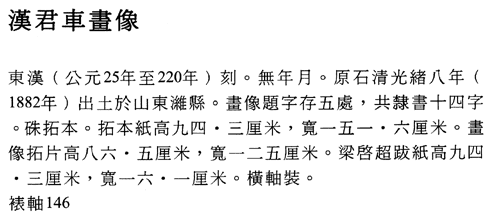 |
|
|
 |
|
|
Illustration of a
Han-Dynasty Procession with Chariot and Cavalrymen Eastern
Han dynasty (25�220 c.e.),
undated, ca. middle to late second century Stone
carved in low relief and engraved in clerical script; unearthed in 1882 at Linzi,
Shandong Province Horizontal
hanging scroll, cinnabar rubbed on paper: 94.3 x 151.6 cm; dimensions of stone
slab in rubbing: 86.5 x 125.0 cm; colophon in ink on paper mounted beside left
edge of rubbing: 94.3 x 16.1 cm Date
of rubbing not given, late Qing dynasty (1644�1911), between 1882 and 1909 Inventory number: Biaozhou 146 This
rubbing was taken from one of the best-known examples of ancient pictorial
stones.� The bas-relief imagery on this
striking cinnabar rubbing is from a funerary chamber in Shandong Province.� In the upper register a lord or important
official is seated in a canopied chariot followed by three cavalrymen.� In the lower register are another three cavalrymen. This
original stone fragment was formerly kept on the estate of the late Qing
scholar and epigrapher Chen Jieqi (1813�1884), who had built a pavilion for the
sole purpose of protecting it, and whose family members made this fine cinnabar
rubbing.� However, even before the
archaeologist �douard Chavannes (1865�1918) published it for the first time in
1909, it had been purchased and shipped to France.� Like the Chinese the French valued not only the pictorial imagery
but the clerical-script inscriptions on the relief panel as well.� The stone is believed to have entered a
Parisian museum, as the attached colophon by Liang Qichao (1873�1929) states
with a palpable tone of regret. |
 |